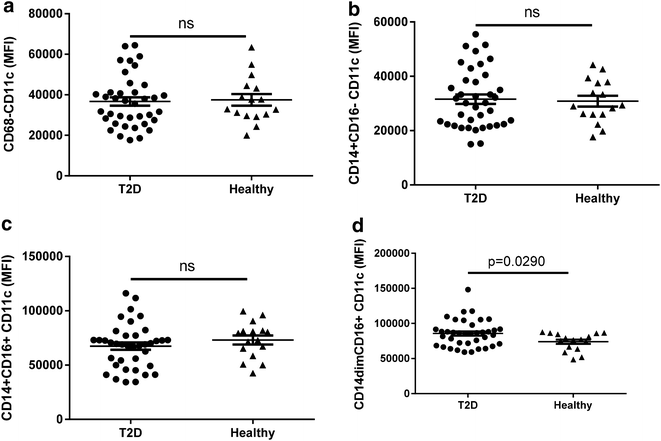Impaired coronary microcirculation in type 2 diabetic patients is associated with elevated circulating regulatory T cells and reduced number of IL-21R⁺ T cells
- PMID: 27095356
- PMCID: PMC4837587
- DOI: 10.1186/s12933-016-0378-5
Impaired coronary microcirculation in type 2 diabetic patients is associated with elevated circulating regulatory T cells and reduced number of IL-21R⁺ T cells
Abstract
Background: Low-grade systemic inflammation is considered to participate in the progression of type 2 diabetes (T2D) and in diabetic complications.
Methods: To determine if circulating leukocytes were abnormally regulated in T2D patients, 8-color flow-cytometry (FACS) analysis was performed in a cross-sectional study of 37 T2D patients and 16 controls. Data obtained from the FACS analysis were compared to coronary flow reserve (CFR), assessed by Rb(82)-PET-imaging, to uncover inflammatory signatures associated with impaired CFR.
Results: Presence of T2D was associated with T cell attenuation characterized by reduced overall T cell, Th17, IL-21R(+), Treg's and TLR4(+) T cells, while the monocyte population showed enhanced TLR4 expression. Further, our data revealed reduced M1-like CD11c expression in T2D which was associated with impaired CFR. In contrast, we show, for the first time in T2D, increased TLR4 expression on CD8 T cells, increased Treg cell number and Treg maturation and reduced IL-21R expression on CD8 T cells to be functionally associated with impaired CFR.
Conclusions: Our demonstration that HbA1c inversely correlates to several T cell populations suggests that T cells may play disease modulating roles in T2D. Further, the novel association between impaired CFR and regulatory T cells and IL-21R(+) T cells imply an intricate balance in maintaining tissue homeostasis in vascular diabetic complications.
Keywords: Cardiovascular disease; Coronary flow reserve; Coronary microcirculation; Flow-cytometry (FACS) analysis; Inflammation; Monocyte sub-populations; Peripheral blood; Type 2 diabetes.
Figures








Similar articles
-
Coronary microvascular function is independently associated with left ventricular filling pressure in patients with type 2 diabetes mellitus.Cardiovasc Diabetol. 2015 Aug 5;14:98. doi: 10.1186/s12933-015-0263-7. Cardiovasc Diabetol. 2015. PMID: 26242308 Free PMC article.
-
Metabolic syndrome individuals with and without type 2 diabetes mellitus present generalized vascular dysfunction: cross-sectional study.Arterioscler Thromb Vasc Biol. 2015 Apr;35(4):1022-9. doi: 10.1161/ATVBAHA.114.304591. Epub 2015 Feb 5. Arterioscler Thromb Vasc Biol. 2015. PMID: 25657309 Clinical Trial.
-
Regulatory T cells with CD62L or TNFR2 expression in young type 1 diabetic patients: relation to inflammation, glycemic control and micro-vascular complications.J Diabetes Complications. 2015 Jan-Feb;29(1):120-6. doi: 10.1016/j.jdiacomp.2014.07.004. Epub 2014 Jul 15. J Diabetes Complications. 2015. PMID: 25113439
-
Diabetes and microvascular pathophysiology: role of epidermal growth factor receptor tyrosine kinase.Diabetes Metab Res Rev. 2010 Jan;26(1):13-6. doi: 10.1002/dmrr.1050. Diabetes Metab Res Rev. 2010. PMID: 19943320 Free PMC article. Review.
-
Genetic and environmental factors associated with type 2 diabetes and diabetic vascular complications.Rev Diabet Stud. 2012 Spring;9(1):6-22. doi: 10.1900/RDS.2012.9.6. Epub 2012 May 10. Rev Diabet Stud. 2012. PMID: 22972441 Free PMC article. Review.
Cited by
-
The Association Between Monocyte Subsets and Cardiometabolic Disorders/Cardiovascular Disease: A Systematic Review and Meta-Analysis.Front Cardiovasc Med. 2021 Feb 17;8:640124. doi: 10.3389/fcvm.2021.640124. eCollection 2021. Front Cardiovasc Med. 2021. PMID: 33681309 Free PMC article.
-
Could IL-17A Be a Novel Therapeutic Target in Diabetic Nephropathy?J Clin Med. 2020 Jan 19;9(1):272. doi: 10.3390/jcm9010272. J Clin Med. 2020. PMID: 31963845 Free PMC article. Review.
-
Diabetes, cardiovascular disease and the microcirculation.Cardiovasc Diabetol. 2018 Apr 18;17(1):57. doi: 10.1186/s12933-018-0703-2. Cardiovasc Diabetol. 2018. PMID: 29669543 Free PMC article. Review.
-
CircRNAs in exosomes from high glucose-treated glomerular endothelial cells activate mesangial cells.Am J Transl Res. 2019 Aug 15;11(8):4667-4682. eCollection 2019. Am J Transl Res. 2019. PMID: 31497190 Free PMC article.
-
Luteinizing hormone is independently associated with high-sensitive cardiac troponin T elevation in postmenopausal T2DM patients: A cross-sectional study.J Diabetes. 2024 Oct;16(10):e70005. doi: 10.1111/1753-0407.70005. J Diabetes. 2024. PMID: 39436203 Free PMC article.
References
-
- Mirza S, Hossain M, Mathews C, Martinez P, Pino P, Gay JL, et al. Type 2-diabetes is associated with elevated levels of TNF-alpha, IL-6 and adiponectin and low levels of leptin in a population of Mexican Americans: a cross-sectional study. Cytokine. 2012;57(1):136–142. doi: 10.1016/j.cyto.2011.09.029. - DOI - PMC - PubMed
MeSH terms
Substances
LinkOut - more resources
Full Text Sources
Other Literature Sources
Medical
Research Materials

